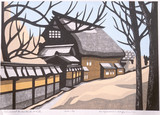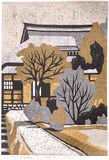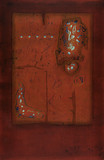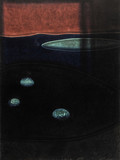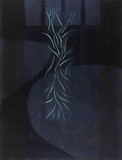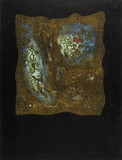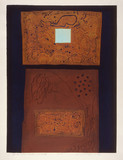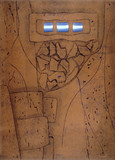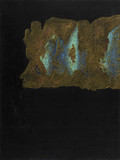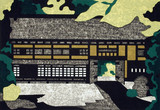Information from Portland Art Museum:
Tajima Hiroyuki, 田嶋宏行, 1911-1997: Tajima emerged during the 1960s as a major figure in contemporary Japanese prints and soon became known for his inventive combinations and manipulations of media. He studied art at both Nihon University and Tokyo Art School, and he also sought out instruction in fabric dyeing and watercolor painting. After World War II, he produced abstact oil paintings and was involved in the revival of surrealist abstraction, a style that had been banned by the militarists. His experimental art-making moved in a new direction after learning woodblock printing from Nagase Yoshirô (1891-1978), to which he applied color photography processes. Late in life, Tajima moved away from graphic art to writing and the study of the tea ceremony.
Tajima's prints are characterized by a three-dimensional quality that stems from his idiosyncratic techniques. He chisels, shellacs, and distresses his blocks, and coats the block with a variety of pigments, textile dyes, and oil emulsions to create a complex, textured surface. The results are incandescent, memorable compositions.
Information from Annex Galleries: Hiroyuki Tajima was born in Tokyo, Japan in 1911. He studied art at Nihon University, graduating in 1932, and the Tokyo School of Arts where he graduated in 1934, having specialized in western style painting. In 1943, he graduated from the Western-style painting division of the Tokyo School of Fine Arts.
He also studied fabric dyeing under Hirokawa Matsugoro (1889-1952) and woodblock printing with the sosaku hanga artist Nagase Yoshiro (1891-1978), a founding father of the Japan Print Association (Hanga Kyokai). In 1946, inspired by and attracted to the artistic ideals of Dada and Surrealism, he joined Bijutsu Bunka Kyokai, a group dedicated to exploring and reviving the abstract and surrealist painting ideals that had been suppressed during WWII. He created his first print also in 1946.
In describing Tajima's work Francis Blakemore comments: "Every Tajima work seems to glow from behind, as though it incorporated a fluorescent light shielded by a mysteriously textured fabric. ... Tajima's technique consists of brushing intensely colored dyes over a dark-colored medium, imparting luminosity to the white areas while enriching the basic colors of the print. The textured areas fade off into dark planes, seeming to float on a cool liquid. Thus the fascinating, bubbly shapes are set off by simple, relaxing ground forms. In this end, this rare combination of intricacy and confident simplicity makes Tajima's work both exciting and reassuring."
In order to create his unique woodblocks Tajima developed his own ink using powdered color mixed with the plastic medium phenol formaldehyde resin (Bakelite). The resin is extremely water-repellant. He uses this ink for a pattern block and then prints again with a water-based ink or dye, which color the areas not printed by the special ink.
In 1969 he began making prints on canvas using much the same techniques but soon abandoned it. He also created a body of popular landscape prints using the name Nagai Kiyoshi, which paid the bills.
https://www.yuikobo.jp/profile/museum%2002.htm Profile in Japanese. Died at home 1997.
